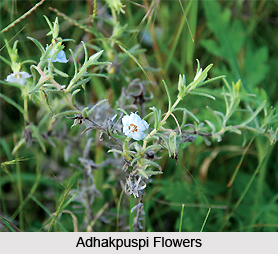Adhakpuspi is an Indian medicinal plant found in the Indian subcontinent. These are widely distributed as a weed throughout India. They grow to an altitude of about 1500 m in the Himalayas, typically on roadsides, in cultivated fields, on dry stony wasteland, and on black cotton soil in peninsular India.
 The botanical name of Adhakpuspi plant is Trichodesma indicum L. This medicinal plant has numerous common names which vary according to the different languages of India. the major common names are Chhotokalpa, Chotokulpa in Bengali, Undhaphuli in Gujarati; Andhahuli, Chhotokalpa, Chhotakulpha, Hetamundiya, Ondhaphuli, Ratmandi in Hindi; Adho-Mukhi, Kattethumbesoppu in Kannada; Chho-Taphulya, Lahanakalpa, Pathari in Marathi; Hetamundia in Oriya; Andusi, Kallributi, Nilakrai, Ratmandu in Punjabi; Adhakpuspi, Adhapushpi, Surasa in Sanskrit; kalhudaitum-bai, kazhuthaithumbai in Tamil and Guvvagutti in Telegu.
The botanical name of Adhakpuspi plant is Trichodesma indicum L. This medicinal plant has numerous common names which vary according to the different languages of India. the major common names are Chhotokalpa, Chotokulpa in Bengali, Undhaphuli in Gujarati; Andhahuli, Chhotokalpa, Chhotakulpha, Hetamundiya, Ondhaphuli, Ratmandi in Hindi; Adho-Mukhi, Kattethumbesoppu in Kannada; Chho-Taphulya, Lahanakalpa, Pathari in Marathi; Hetamundia in Oriya; Andusi, Kallributi, Nilakrai, Ratmandu in Punjabi; Adhakpuspi, Adhapushpi, Surasa in Sanskrit; kalhudaitum-bai, kazhuthaithumbai in Tamil and Guvvagutti in Telegu.
Adhakpuspi plant is a wiry, hispid, erect annual herb which varies from 15cm to 45 cm in height. Leaves of this medicinal plant are opposite, and variable in size and shape. These are usually sessile, have 2.5 cm to 10 cm length. The upper surfaces of leaves are clothed with stiff hair arising from circular tubercles and the lower surfaces consist of more or less densely villous. Flowers are pale blue in colour but often change to pink or white. They are solitary and in terminal few-flowered cymes; pedicels vary from 0.6-1.3 cm long, slender and hispid.
The calyx of the Adhakpuspi plants are 1.1-1.3 cm long, deeply divided, with long hairs, segments lanceolate, acute, hastate at base and connate by the basal auricles. The corolla of Adhakpuspi plant is 1.3 cm long, tube 6 mm long, limb oblique with thinly hairy to the inner portion. Fruits are pyramidal and has 4-ribbed which is enclosed in an enlarged calyx. These become bluish-white or almost white when ripe.
Adhakpuspi plants are important for its medicinal properties. Several medicines are prepared from the plant parts. The Adhakpuspi plant is useful in Ayurveda and Unani medicines. This herb provides diuretic properties in Unani medicine. In Ayurvedic practice the whole plant and root are used for the treatment of arthritis, anorexia, sprue, dysentery, skin diseases, snake-bite poisoning and fever. The roots are crushed and made into a paste, which is applied externally to relieve swollen joints and to superficial skin injuries. The crushed roots are mixed with water, or its decoction, is given to children to relieve dysentery. The flowers are reportedly used as a sudorific and pectoral. Both the leaves and flowers of this plant are edible.



















